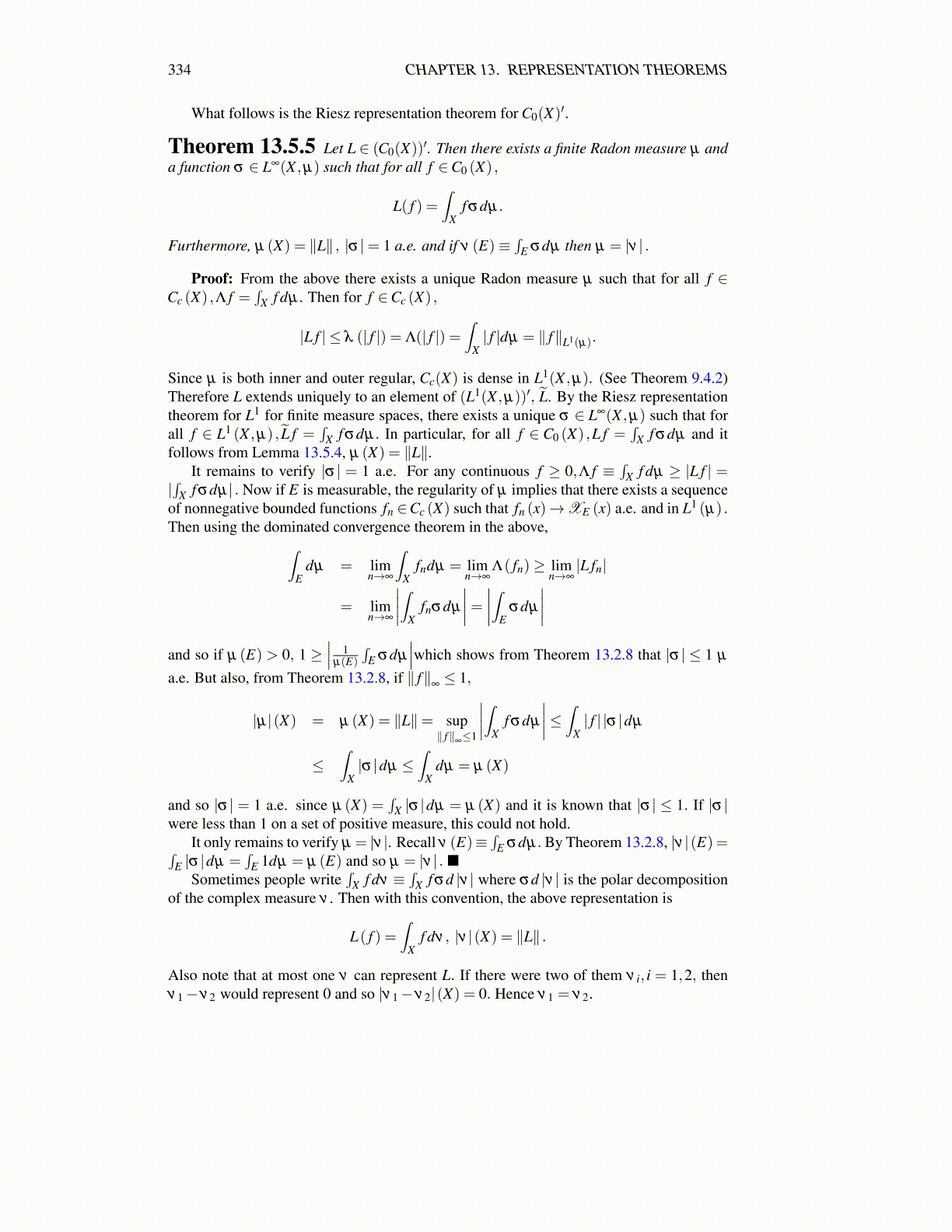
334 CHAPTER 13. REPRESENTATION THEOREMS
What follows is the Riesz representation theorem for C0(X)′.
Theorem 13.5.5 Let L ∈ (C0(X))′. Then there exists a finite Radon measure µ anda function σ ∈ L∞(X ,µ) such that for all f ∈C0 (X) ,
L( f ) =∫
Xf σdµ.
Furthermore, µ (X) = ∥L∥ , |σ |= 1 a.e. and if ν (E)≡∫
E σdµ then µ = |ν | .
Proof: From the above there exists a unique Radon measure µ such that for all f ∈Cc (X) ,Λ f =
∫X f dµ . Then for f ∈Cc (X) ,
|L f | ≤ λ (| f |) = Λ(| f |) =∫
X| f |dµ = ∥ f∥L1(µ).
Since µ is both inner and outer regular, Cc(X) is dense in L1(X ,µ). (See Theorem 9.4.2)Therefore L extends uniquely to an element of (L1(X ,µ))′, L̃. By the Riesz representationtheorem for L1 for finite measure spaces, there exists a unique σ ∈ L∞(X ,µ) such that forall f ∈ L1 (X ,µ) , L̃ f =
∫X f σdµ. In particular, for all f ∈ C0 (X) ,L f =
∫X f σdµ and it
follows from Lemma 13.5.4, µ (X) = ∥L∥.It remains to verify |σ | = 1 a.e. For any continuous f ≥ 0,Λ f ≡
∫X f dµ ≥ |L f | =
|∫
X f σdµ| . Now if E is measurable, the regularity of µ implies that there exists a sequenceof nonnegative bounded functions fn ∈Cc (X) such that fn (x)→XE (x) a.e. and in L1 (µ) .Then using the dominated convergence theorem in the above,∫
Edµ = lim
n→∞
∫X
fndµ = limn→∞
Λ( fn)≥ limn→∞|L fn|
= limn→∞
∣∣∣∣∫Xfnσdµ
∣∣∣∣= ∣∣∣∣∫Eσdµ
∣∣∣∣and so if µ (E) > 0, 1 ≥
∣∣∣ 1µ(E)
∫E σdµ
∣∣∣which shows from Theorem 13.2.8 that |σ | ≤ 1 µ
a.e. But also, from Theorem 13.2.8, if ∥ f∥∞≤ 1,
|µ|(X) = µ (X) = ∥L∥= sup∥ f∥∞≤1
∣∣∣∣∫Xf σdµ
∣∣∣∣≤ ∫X| f | |σ |dµ
≤∫
X|σ |dµ ≤
∫X
dµ = µ (X)
and so |σ | = 1 a.e. since µ (X) =∫
X |σ |dµ = µ (X) and it is known that |σ | ≤ 1. If |σ |were less than 1 on a set of positive measure, this could not hold.
It only remains to verify µ = |ν |. Recall ν (E)≡∫
E σdµ. By Theorem 13.2.8, |ν |(E) =∫E |σ |dµ =
∫E 1dµ = µ (E) and so µ = |ν | . ■
Sometimes people write∫
X f dν ≡∫
X f σd |ν | where σd |ν | is the polar decompositionof the complex measure ν . Then with this convention, the above representation is
L( f ) =∫
Xf dν , |ν |(X) = ∥L∥ .
Also note that at most one ν can represent L. If there were two of them ν i, i = 1,2, thenν1−ν2 would represent 0 and so |ν1−ν2|(X) = 0. Hence ν1 = ν2.